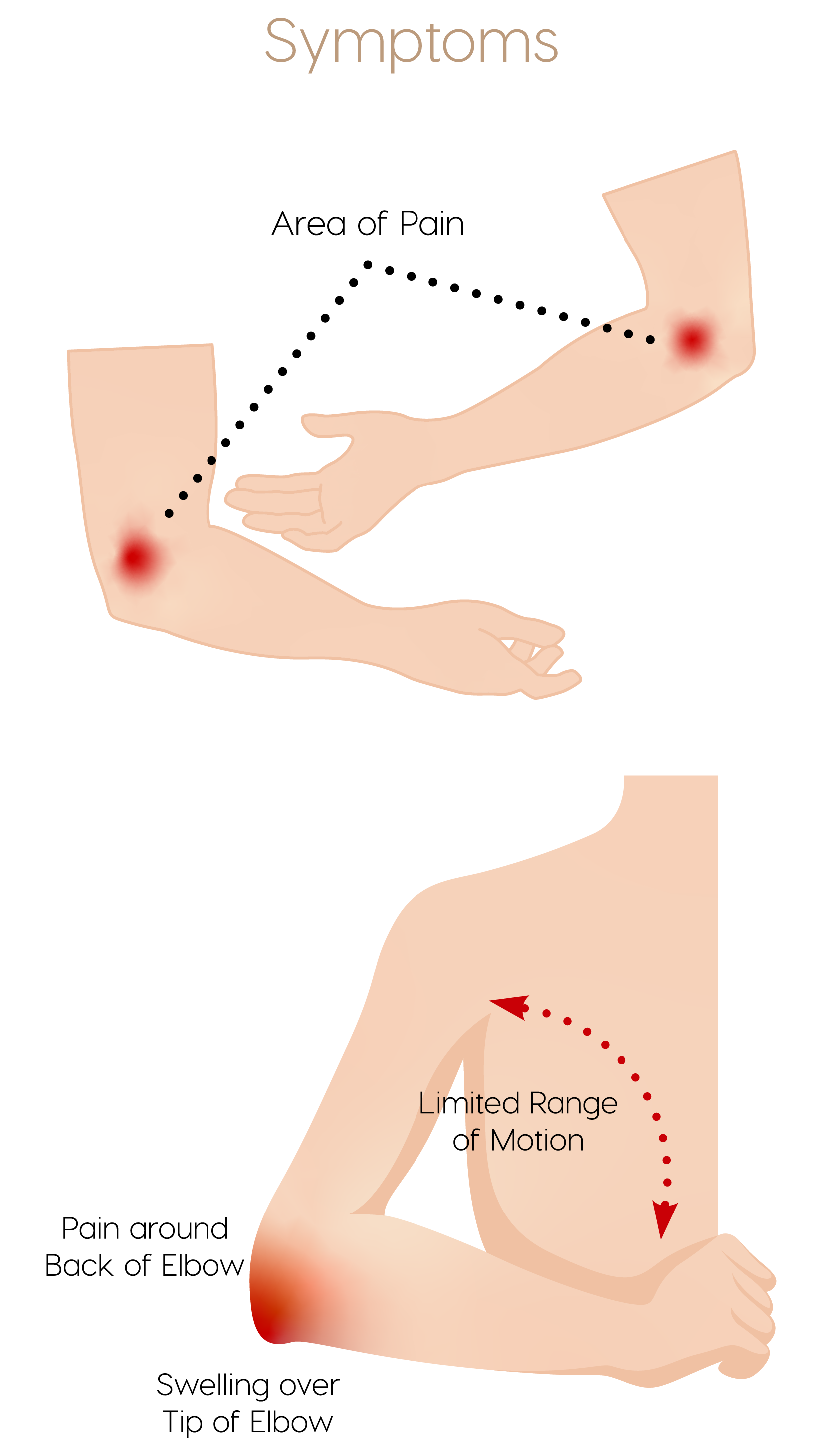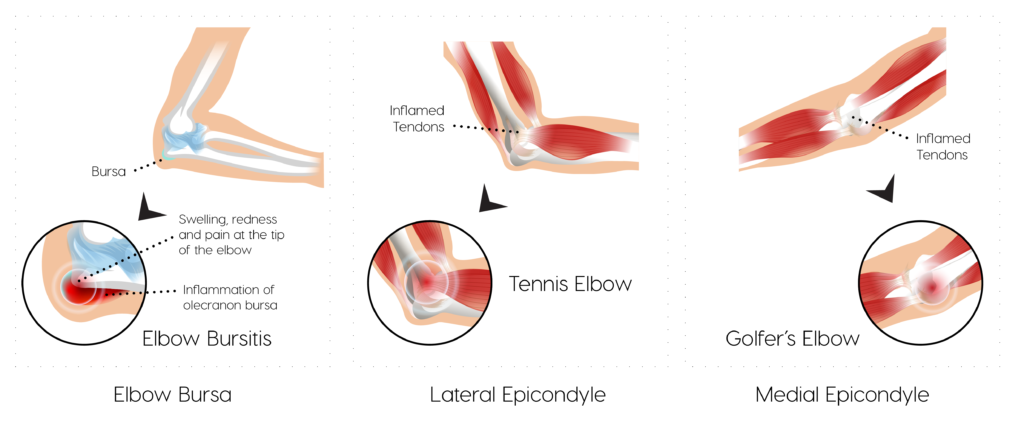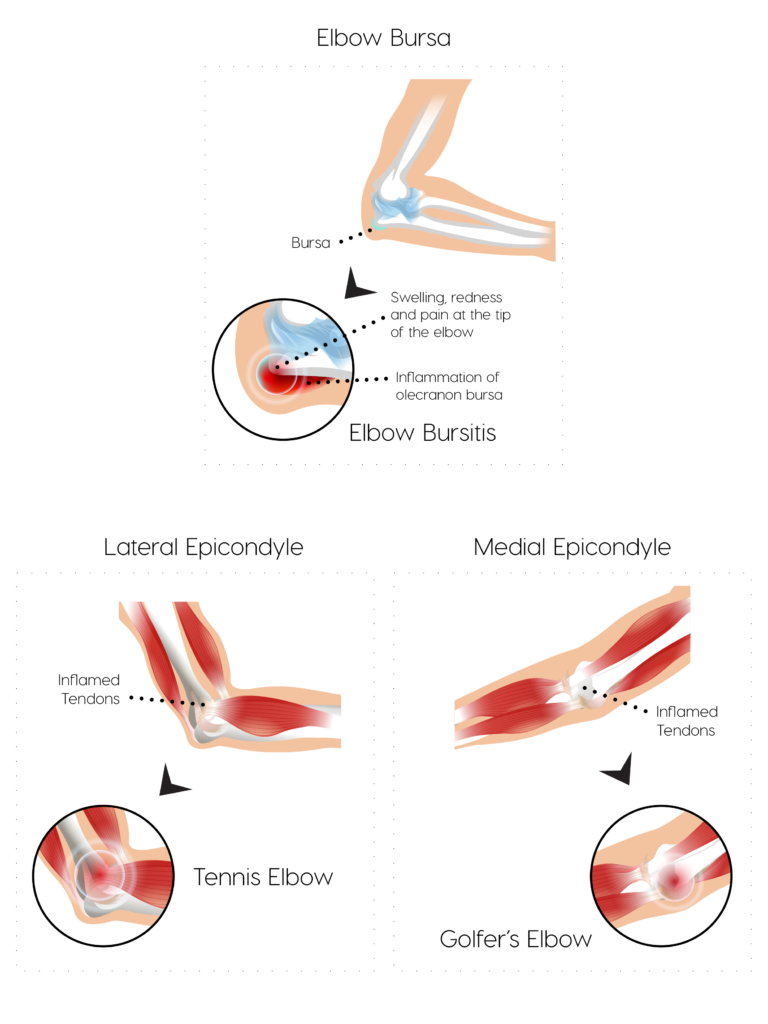powered by
Elbow Ultrasound
- SAME Day or NEXT Day Appointments
- FREE consultation to make sure this is the right scan for you
- Performed by a CONSULTANT RADIOLOGIST
- PRICE: £175
An ultrasound scan of the elbow is performed to have a look at the elbow joint and the muscles and tendons surrounding the elbow. It can also be used to get a quick look at the biceps and triceps muscles.


Anatomy & conditions


Common conditions
An elbow ultrasound scan is useful in evaluating the following conditions:
- What is Olecranon Bursitis?
Olecranon Bursitis is caused by the inflammation of the fluid sac that is between the olecranon (point of the elbow) and the skin. - How common is it?
Olecranon Bursitis is a fairly common condition. - Does it affect males and females?
It can affect both men and women. - What age groups?
The majority of people who suffer from Olecranon Bursitis are men between the ages of 30 and 60. - What are the main symptoms?
Common symptoms include localised swelling and tenderness, pain on movement, and redness. - How is it tested for?
A doctor will conduct a physical exam of the joint for swelling, redness and assess range of motion. If the condition requires further testing the doctor may do an aspiration when they remove fluid from the bursa with a syringe and send it to a lab to test for infection. - How is it treated?
Wearing elbow pads to protect the elbow can be used as well as avoiding any activities that may put pressure on the elbow and taking medications such as anti-inflammatories to reduce swelling and pain.
- What is Bursitis (General)?
Bursitis is a condition that affects the joints and causes pain when the fluid-filled sacs between bones, tendons, joints, and muscles become inflamed. - How common is it?
Bursitis is common in people who play sports or engage in repetitive activities that put pressure on the bursae around a joint. - Does it affect males and females?
It can affect both men and women. - What age groups?
Bursitis is more likely to occur in people that are over the age of 50. - What are the main symptoms?
Symptoms of bursitis include pain and the sudden inability to move a joint. There can be excessive swelling, redness, bruising or possibly a rash in the area, sharp shooting pains and sometimes a fever. - How is it tested for?
Imaging tests can be conducted to diagnose bursitis such as an X-ray, aspiration in which fluid is taken by a syringe from the swollen bursa and blood tests can also be done to rule out evidence of infection. - How is it treated?
A patient must rest and avoid overusing the injured joint, apply ice to reduce any swelling, and physiotherapy to strengthen the muscles to relieve pain. In chronic cases corticosteroid can help.
- What is Tennis Elbow?
When tendons in the elbow are overloaded and repetitively used, a person can develop a Tennis Elbow. - How common is it?
Tennis Elbow is common in people who have jobs that require repetitive motions of the arm and wrist. - Does it affect males and females?
It can affect both men and women. - What age groups?
Tennis Elbow usually affects men and women between the ages of 30-50 years old. - What are the main symptoms?
Tennis elbow symptoms include pain and tenderness of the bone on the outside of the elbow. The pain may radiate into the upper or lower arm and also hurt when a person does things involving their hands. - How is it tested for?
A physical exam will be done on the affected arm to assess range of motion, swelling, and pain. - How is it treated?
The most common treatments for Tennis Elbow are simply icing the elbow to reduce swelling and pain, as well as limiting movements of the elbow or using elbow pads to avoid further strain and pressure on the elbow. In severe cases surgery is needed.
- What is Golfer’s Elbow?
Golfer’s Elbow is a condition that causes pain and inflammation in the tendons connecting the forearm to the elbow. - How common is it?
Golfer’s Elbow is common in people who go from rarely using their forearm muscles to using them a lot. - Does it affect males and females?
It can affect both men and women. - What age groups?
Anyone can get a Golfer’s Elbow at any point in their lives though it is most common in those between the ages of 35 and 50 years old. - What are the main symptoms?
The most common signs of Golfer’s Elbow are pain and tenderness on the inner side of the elbow that can extend along the forearm, a general stiffness of the elbow, weakness in the wrists and hands and a possible numbing sensation or tingling in the joint. - How is it tested for?
There is a physical test specifically for Golfer’s Elbow called the Golfer’s Elbow Test in which a physician will test for swelling, range of motion and pain in the joint by moving and extending the arm. - How is it treated?
It is important to seek medical help quickly if a person suspects they may be suffering from Golfer’s Elbow. It is treated with ice to reduce swelling, rest and avoid the use of the joint. In some cases a splint may be recommended to limit stress on the tendons.
Risks
Ultrasound scan of the elbow is a safe procedure and has no known risks.
How to prepare
No specific preparation is required for this scan.
What you can expect
Before your ultrasound, you may be asked to change into a gown and to remove any jewelry. You will be asked to sit on an examination table.
A radiologist will perform your scan. A small amount of ultrasound gel is applied to your elbow. The gel enables the ultrasound device to provide better images.
The radiologist will gently press an ultrasound probe against various points on your elbow and upper arm. They will also ask you to move the elbow and arm into specific positions. Depending upon your symptoms you may experience some pain during this scan. The radiologist will always try to make the scan as comfortable as possible. If you take regular pain medication please have these to hand when you have your scan as you may be a little sore afterwards. An elbow ultrasound scan takes around 30 minutes to complete.
You will be able to return to normal activities immediately after your scan.
Results
The radiologist will prepare a written report immediately after your scan. You can wait for the written report and should you wish, a copy of your scan images can be sent to you via email so you have them to hand at all times.
Follow up with Rejuvence Scans
We always recommend booking a consultation immediately after your scan with one of our doctors to discuss the results of your scan and to provide advice regarding any further investigations and/or treatment. Further investigations and treatment can include:
Blood tests
Referral to a specialist (Private/NHS)
Referral for further imaging (Private MRI)
* Please note that for referrals back to the NHS you will still have to go via your GP but Rejuvence Scans will provide a full report and cover letter in support of the referral.
Ultrasound guided drainage of bursitis
For immediate symptomatic relief it is possible to perform ultrasound guided drainage of large swellings around the elbow. The fluid drained can also be sent off to the lab to identify the presence of any infection. Following drainage a course of antibiotics will normally be prescribed.
Ultrasound guided joint injections
Following identification of certain injuries or conditions we are also able to offer ultrasound guided cortisone (steroid) injections. Cortisone injections help to reduce inflammation and if combined with local anaesthetic can provide significant pain relief for upto 6 weeks.
Using the Magellan system ultrasound guided biocellular injections can help to accelerate the repair of muscle injuries. This is a treatment elite athletes often use to come back from injury quicker.
